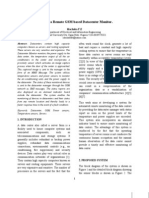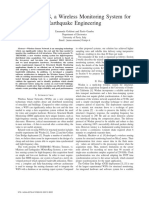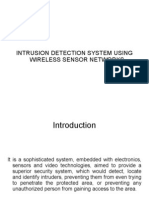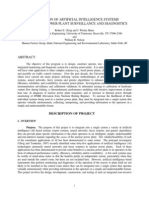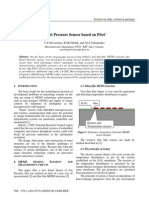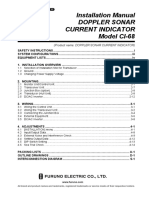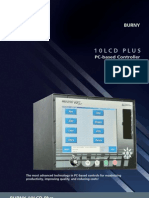Nuclear Facility Radiation Monitoring System: Keiichi Ooi Katsumi Yasutomo Zenjiro Suzuki
Nuclear Facility Radiation Monitoring System: Keiichi Ooi Katsumi Yasutomo Zenjiro Suzuki
Uploaded by
Vraja DasiCopyright:
Available Formats
Nuclear Facility Radiation Monitoring System: Keiichi Ooi Katsumi Yasutomo Zenjiro Suzuki
Nuclear Facility Radiation Monitoring System: Keiichi Ooi Katsumi Yasutomo Zenjiro Suzuki
Uploaded by
Vraja DasiOriginal Title
Copyright
Available Formats
Share this document
Did you find this document useful?
Is this content inappropriate?
Copyright:
Available Formats
Nuclear Facility Radiation Monitoring System: Keiichi Ooi Katsumi Yasutomo Zenjiro Suzuki
Nuclear Facility Radiation Monitoring System: Keiichi Ooi Katsumi Yasutomo Zenjiro Suzuki
Uploaded by
Vraja DasiCopyright:
Available Formats
Nuclear Facility Radiation
Monitoring System
Keiichi Ooi
Katsumi Yasutomo
Zenjiro Suzuki
1. Introduction to-1 correspondence.
Applying the conventional system configuration to
Radiation control at nuclear power facilities is im- a monitoring system having a large number of radia-
plemented in accordance with various laws and regula- tion monitors distributed throughout multiple facilities
tions for the safety of workers in the facility and local would require the construction of an enormous hard-
residents. Radiation monitoring systems are critical ware structure, and this was a limiting factor for sys-
systems that operate 24 hours a day, monitoring the tem construction.
radiation conditions in work environments inside the Recently, as radiation control at nuclear power fa-
facility and the radiation concentrations in air and flu- cilities becomes more advanced, radiation monitoring
ids discharged outside the facility. systems are being required to provide improved reli-
In a radiation monitoring system, the data signals ability, labor saving maintenance and inspections, and
from radiation detectors installed at each worksite are enhanced monitoring functions.
transmitted to a central control room where radiation Meanwhile, there has been remarkable progress in
levels and alarm activation are monitored on a ra- the development of IC and other semiconductor tech-
diation monitoring panel and where a radiation control nology, transmission processing technology and data
computer processes the data and outputs the data on a processing technology.
display or as a printout. Under these conditions, Fuji Electric is providing
In conventional systems, extremely weak radia- large-scale radiation monitoring systems that incorpo-
tion signals had to be converted into electrical signals, rate the latest technology, and this paper introduces
amplified and then transmitted. Furthermore, the these systems.
detection mechanisms differed according to the type
of radiation to be measured, and as a result, the latter 2. Overview
stage signal transmission methods also differed, and
the radiation detectors installed at each worksite and Fuji Electric has developed radiation monitoring
the radiation monitoring panel which installed in the systems in accordance with the following objectives.
central control room were connected by cables in a 1- (1) To develop new semiconductor radiation sensors in
Fig.1 Concept of nuclear power facility radiation monitoring system
Radiation monitors Data transmission system Monitoring system
Media
Area
converter
monitor Ethernet Ethernet Radiation
detectors monitoring
panel
Dust
monitor
detectors
Computer
system
Gas
monitor
detectors
114 Vol. 53 No. 4 FUJI ELECTRIC REVIEW
order to increase the detection sensitivity (efficien- always-on self-diagnostic function and a remote auto-
cy). mated inspection function were added to realize labor
(2) To make radiation detectors more intelligent and savings for maintenance and inspections. Additionally,
to improve their reliability and maintainabil- the radiation sensor uses a newly developed large-size
ity, to integrate into a radiation detector the char- semiconductor sensor.
acteristic functions for radiation measurement A data transmission system can be constructed
(configured with custom circuits for each type of flexibly according to the number of detectors to be con-
radiation to be measured, α-ray, β-ray, γ-ray and so nected and the size of the facility. Figure 1 shows a
on, since signal levels vary according the type of schematic diagram of a large-scale system in the case
measurement) having been distributed previously where Ethernet is used as the transmission interface.
between a central control room and onsite loca- Each radiation detector's output is in Ethernet 100
tions, and to use a general-purpose transmission BASE-TX format, transmitted through a media con-
interface. verter to transfer large quantities of data optically to a
(3) To incorporate the latest data transmission tech- central radiation monitoring and control system.
nology in the transmission of signals from the ra-
diation detectors to a central control room or to a 3. Radiation Monitors
radiation control computer, and to achieve higher
reliability and faster transmission speeds for large The functional configuration of a radiation detec-
amounts of data. tor is shown in Fig. 2. Previously, radiation monitors
The configuration of a developed system based on were provided with onsite sensors and pre-amps only,
these objectives is shown in Fig. 1. and the remaining functions were all housed in a ra-
All the functions required to measure radiation diation monitoring panel. In the past, a monitor loop
were successfully installed in a radiation monitor, and was formed by assembling multiple hardware modules
the signal processing results are output as digital data. according to the type of each sensor, but now using a
The transmission interface is the IEEE-802.3 standard
(Ethernet*1), regardless of the type of monitor, and an *1: Ethernet is a registered trademark of Xerox Corp., USA.
Fig.2 Radiation detector functions and configuration
Pulse Pulse height Pulse Data Measured
Sensor Pre-amp Selector
shaping discriminator counter processor values, etc.
Time constant processing
I /O interface
Pulse Unit conversion
Light Testing Alarm
pulse evaluation unit Alarms Ethernet
circuit
generator
Alarm setting value storage
Alarm evaluation
(highest, high, low)
Self- Self-diagnostic Failure details
diagnostic
circuit unit Test results
Failure alarm evaluation
Test result evaluation
Bias Low voltage +24 V power supply
source power supply
Sensor part Measurement part
Table 1 Types and main functions of radiation detectors
Main specifications
Monitor types
Detectors Measurement range
−2 4
Ionization chamber detector 10 to 10 µSv / h
γ-ray area monitor −1 4
Semiconductor detector 10 to 10 µSv / h
3 −2 4
Neutron area monitor He proportional counter tube 10 to 10 µSv / h
−2 4
α-ray dust monitor Semiconductor detector 10 to 10 s−1 (cps)
−1 5
β-ray dust monitor Semiconductor detector 10 to 10 s−1 (cps)
−1 5
β-ray gas monitor Plastic scintillation detector 10 to 10 s−1 (cps)
−1 5
Iodine monitor NaI (Tl) scintillation detector 10 to 10 s−1 (cps)
Nuclear Facility Radiation Monitoring System 115
single-chip micro computer, and all these functions are circuit by incrementing and decrementing inputted
incorporated into a single CPU board and housed in data and verifying the alarm output.
the detector. (3) Maximum and minimum calibration
A radiation detector consists of a sensor part and a An internal test circuit produces electrical pulses
measuring part. Common functions that do not depend which are counted to verify the maximum and mini-
on the type of monitor are provided in the measuring mum limits of the measurement range.
part and functions that differ according to the type of Table 1 lists the main specifications of radiation
radiation to be measured are provided in the sensor detectors.
part. Figure 3 shows a neutron area monitor detec-
The radiation detector has the following always- tor. The energy range to be measured is 0.025 eV to
on self-diagnostic functions, and sends an automatic 15 MeV, which sufficiently covers the range of energy of
transmission to the data monitoring and control sys- neutrons emitted from a nuclear power facility. (Exter-
tem when an abnormality occurs. nal dimensions: approx. 257 mm (dia.) × 388 mm (H) ×
(1) Continuous monitoring of discrimination level 250 mm (dia.) (bottom); Mass: approx. 15 kg.)
(2) Continuous bias voltage monitoring Figure 4 shows a semiconductor γ-ray area moni-
(3) CPU checking (RAM, ROM) tor detector that is capable of measuring energy in
(4) Continuous DO / AO monitoring the range from 55 to 1,500 keV. (External dimensions:
(5) Continuous monitoring for temperature abnor- 120 mm (W) × 100 mm (D) × 190 mm (H); Mass: approx
malities 1.3 kg.)
Additionally, the radiation detector also has a func- Figure 5 shows the measurement part combined
tion for receiving remote commands from the central with the detector (sensor). The front panel has an
control room, implementing the following tests auto- LCD display, and can display measured radiation val-
matically, and notifying the central control room of the ues. Various settings and operations are controlled by
results. a dedicated infrared ray remote controller. Changes
(1) Light pulse test to the alarm setting value and the like can be accom-
An internal light pulse generator produces light plished by remote operation via a LAN. An alarm dis-
pulses to verify the integrity of the entire monitor play is installed on the upper side, and alarms can be
loop, including the sensors. The frequency of the light displayed or sounded at an onsite location. (External
pulses can be set arbitrarily by the radiation monitor- dimensions: 190 mm (W) × 70 mm (D) × 242 mm (H),
ing system. not including projections; Mass: approx. 2.7 kg.)
(2) Alarm test The interface specifications for transmitting data
This test verifies the integrity of an internal alarm to the center from the measuring part are as follows.
(1) Transmission method: IEEE-802.3 standard (Eth-
Fig.3 Neutron area monitor detector ernet)
(2) Transmission data: Radiation measurement val-
ues, alarm contents, failure contents, test results,
etc.
Fig.5 Measurement part
Fig.4 Semiconductor γ-ray area monitor detector
116 Vol. 53 No. 4 FUJI ELECTRIC REVIEW
Fig.6 Configuration of nuclear power facility radiation monitoring system
Radiation monitoring panel
Optical Ethernet
MC
MC Central
Computer
Each monitor Connection box-1 Ethernet
HUB HUB
(max. 30 CH) PLC/A system
MC Ethernet
(max. 30 CH)
HUB
Maximum 30 monitors
in single Ethernet loop PE link
Ethernet
MC
(max. 30 CH)
Ethernet PLC/B system
Each monitor HUB Connection box-n HUB
(max. 30 CH)
MC
Optical Ethernet
MC PE link
SX-bus Maintenance
Display Ethernet
computer
(backup data)
Alarm PLC/C system HUB
indicator lamp
MC : Media converter
HUB : Ethernet switching hub
Recorder
PLC : Programmable logic controller
PE link, SX-bus : Fuji’s original LAN
Fig.7 Example of central computer display monitoring panel. A maximum of 3 radiation monitor
channels are connected to a HUB and are installed at a
suitable location according to the layout of the facility.
A pair of programmable controllers (PLC/A and
PLC / B) are installed in the radiation monitoring panel,
and are connected to each side of the optical Ethernet
via a MC. Radiation monitoring data is transmitted
every second to both of these controllers, enabling data
to be acquired even when there is mechanical failure
of a LAN device onsite or in the monitoring panel. Ad-
ditionally, each radiation monitor is also provided with
an Ethernet interface and can transmit data directly
to a central computer. Figure 7 shows an example of a
central computer display.
The HUB is shared by the system, and may be re-
placed in the case of failure. The PLC / C implements
essential command, data recording and alarm func-
tions at the radiation monitoring panel.
5. Postscript
4. System Configuration
This paper has introduced Fuji Electric’s nuclear
The development of radiation monitors having facility radiation monitoring systems. The systems and
an Ethernet interface enables a radiation monitoring components introduced here have been designed such
system to be constructed according to the size of the that all characteristic functions for radiation measure-
facility. Figure 6 shows an example configuration of a ment are installed in the radiation detector, and the
radiation monitoring system. signal processing results are output as digital data. As
This system is capable of connecting a maximum a result, there are almost no restrictions on the system
of 30 radiation monitor channels in a single Ether- configuration, and future advances in data processing
net loop. Multiple Ethernet loops can be combined to technology will be easy to incorporate.
construct a large-scale system. The signal from each Fuji Electric intends to continue its developmental
radiation monitor is input to an Ethernet switching efforts, aiming for higher reliability, maintainability
hub (HUB), fed through a media converter (MC), and and productivity.
transmitted via an optical Ethernet to the radiation
Nuclear Facility Radiation Monitoring System 117
* All brand names and product names in this journal might be trademarks
or registered trademarks of their respective companies.
You might also like
- GEH-5980E SPEEDTRONIC™ Mark V Turbine Control Maintenance Manual PDFDocument162 pagesGEH-5980E SPEEDTRONIC™ Mark V Turbine Control Maintenance Manual PDFmeirangong91% (11)
- Operating Instructions: D-Lab.1 FamilyDocument524 pagesOperating Instructions: D-Lab.1 FamilyKodak CristalNo ratings yet
- Worley Parsons - Balikpapan Project Overview - 2020Document4 pagesWorley Parsons - Balikpapan Project Overview - 2020Vraja DasiNo ratings yet
- User Manual 45M626U1UK-02Document230 pagesUser Manual 45M626U1UK-02NR-SAN100% (7)
- Digital Materials Handling - HOTDocument23 pagesDigital Materials Handling - HOThuanghenghotNo ratings yet
- A New Computer Based Phasor Measurement Unit FrameworkDocument6 pagesA New Computer Based Phasor Measurement Unit FrameworkABMOHENo ratings yet
- Sbox: Abstract - This Report Shows The Methodology To Develop A CrackDocument2 pagesSbox: Abstract - This Report Shows The Methodology To Develop A CrackJose PucNo ratings yet
- Design of A Remote GSM Based Datacenter Monitor: Idachaba F.EDocument9 pagesDesign of A Remote GSM Based Datacenter Monitor: Idachaba F.EFrancis IdachabaNo ratings yet
- Title: Instrumentation and Measurement Testing in The Real-Time Lab For Automation of Complex Power SystemsDocument8 pagesTitle: Instrumentation and Measurement Testing in The Real-Time Lab For Automation of Complex Power SystemsSamundra GurungNo ratings yet
- C4-201 Insulation Monitoring FinalDocument10 pagesC4-201 Insulation Monitoring FinalMarcosGodoyPereyraNo ratings yet
- An Asynchronous Interrupt Driven Sampling Technique For A Practical Monitoring System of Power-Line Single-Phase Voltage and Current SignalsDocument11 pagesAn Asynchronous Interrupt Driven Sampling Technique For A Practical Monitoring System of Power-Line Single-Phase Voltage and Current SignalsInternational Journal of Power Electronics and Drive SystemsNo ratings yet
- 4th Educational ArticleDocument6 pages4th Educational ArticleFrancisco AugustoNo ratings yet
- 2013 SENSORCOMM Early-Warning System For Machine FailureDocument7 pages2013 SENSORCOMM Early-Warning System For Machine FailureLuqman AzamNo ratings yet
- Envea - Qal 181 - Qal1 Light Scatter - Particulate Cems Monitor - enDocument5 pagesEnvea - Qal 181 - Qal1 Light Scatter - Particulate Cems Monitor - enpedro ortegaNo ratings yet
- Jurnal Kimia Radiasi - F1C1 17 009 - Dicky SaputraDocument5 pagesJurnal Kimia Radiasi - F1C1 17 009 - Dicky Saputradicky saputraNo ratings yet
- 10 1109@MMM 2020 2993477Document12 pages10 1109@MMM 2020 2993477Mujahid AliNo ratings yet
- Phasor Measurement Unit Technology and ItsDocument4 pagesPhasor Measurement Unit Technology and ItsVedaste NdayishimiyeNo ratings yet
- PX C 3877500Document7 pagesPX C 3877500Sanjeev KumarNo ratings yet
- New Technologies For Electric Power Distribution SystemsDocument6 pagesNew Technologies For Electric Power Distribution SystemsmeraatNo ratings yet
- Article H 41 - S. TENBOHLENDocument6 pagesArticle H 41 - S. TENBOHLENGopinath SubramaniNo ratings yet
- W-TREMORS, A Wireless Monitoring System For Earthquake EngineeringDocument6 pagesW-TREMORS, A Wireless Monitoring System For Earthquake EngineeringLamborighini-man GallardoNo ratings yet
- WCL Record 1Document49 pagesWCL Record 1Nandhini PNo ratings yet
- En - MEMS Condition MonitoringDocument17 pagesEn - MEMS Condition MonitoringbogodavidNo ratings yet
- ME0005 (2005) - Validation of An Integrated Network System For Real-Time Wireless Monitoring of Civil StructuresDocument8 pagesME0005 (2005) - Validation of An Integrated Network System For Real-Time Wireless Monitoring of Civil StructuresmetaleroanibalNo ratings yet
- Design and Research of Wireless Optical Power Meter Based o - 2023 - Results inDocument6 pagesDesign and Research of Wireless Optical Power Meter Based o - 2023 - Results inronaldquezada038No ratings yet
- Intrusion Detection System Using Wireless Sensor NetworksDocument14 pagesIntrusion Detection System Using Wireless Sensor Networksvimal laxmanNo ratings yet
- Project Earthquake DetectorDocument7 pagesProject Earthquake Detectorbavihah147No ratings yet
- 4.four Steps For Making Better Power MeasurementsDocument31 pages4.four Steps For Making Better Power MeasurementsMohammed Yasser AlgailanyNo ratings yet
- Application of Artificial Intelligence Methods in DiagnosticsDocument6 pagesApplication of Artificial Intelligence Methods in DiagnosticsYULEIMY YASMIN LUCAS ZASIGANo ratings yet
- A Brief History of Digital ShakersDocument5 pagesA Brief History of Digital ShakersCharles HyndmanNo ratings yet
- Low-Cost Embedded Real-Time Handheld Vibration Smart Sensor For Industrial Equipment Onsite Defect DetectionDocument10 pagesLow-Cost Embedded Real-Time Handheld Vibration Smart Sensor For Industrial Equipment Onsite Defect DetectionArchana DNo ratings yet
- Wireless Sensors Placement For Structural Health Monitoring-A SurveyDocument5 pagesWireless Sensors Placement For Structural Health Monitoring-A SurveyMadhu BalaNo ratings yet
- UNIT-4 Power Quality Monitoring: Terms and Definitions Spectrum AnalyzerDocument9 pagesUNIT-4 Power Quality Monitoring: Terms and Definitions Spectrum AnalyzerMidhun StarlordNo ratings yet
- Vegetation Control of AitDocument22 pagesVegetation Control of Aitbashbashiru1No ratings yet
- Paper 14Document4 pagesPaper 14babakfazelNo ratings yet
- IoT. Lecture 2. Sensors Introduction and IMUDocument27 pagesIoT. Lecture 2. Sensors Introduction and IMU3142588563No ratings yet
- Remote Background Radiation Monitoring Using Zigbee TechnologyDocument11 pagesRemote Background Radiation Monitoring Using Zigbee TechnologygeorgeNo ratings yet
- The Chesapeake Laser Tracker in Industrial: MetrologyDocument18 pagesThe Chesapeake Laser Tracker in Industrial: MetrologyDanielNo ratings yet
- TP EPPE Measuring System Requirements 201501 ENGDocument8 pagesTP EPPE Measuring System Requirements 201501 ENGSiva NandhamNo ratings yet
- Design of Networked Monitor System For Environmental Radioactive AerosolDocument5 pagesDesign of Networked Monitor System For Environmental Radioactive AerosolGerald CastilloNo ratings yet
- Integration of Micro Sensors With Mobile Devices For Monitoring Vital Signs of Sleep Apnea PatientsDocument6 pagesIntegration of Micro Sensors With Mobile Devices For Monitoring Vital Signs of Sleep Apnea PatientsEmily JulianaNo ratings yet
- Smart Metering For Low Voltage Using Arduino Due PDFDocument6 pagesSmart Metering For Low Voltage Using Arduino Due PDFUmeshNo ratings yet
- Product Profile: Electronics Corporation of India LimitedDocument14 pagesProduct Profile: Electronics Corporation of India LimitedNaing HtooNo ratings yet
- Amar PrashantDocument2 pagesAmar Prashantamar_prashant07No ratings yet
- IJEATDocument6 pagesIJEATsundarrajanNo ratings yet
- Integration of Artificial Intelligence Systems For Nuclear Power Plant Surveillance and DiagnosticsDocument9 pagesIntegration of Artificial Intelligence Systems For Nuclear Power Plant Surveillance and DiagnosticsskmrsanjeevNo ratings yet
- Wireless NetworkDocument5 pagesWireless NetworkJournalNX - a Multidisciplinary Peer Reviewed JournalNo ratings yet
- Built-In Test Enabled Diagnosis and Tuning of RF TDocument10 pagesBuilt-In Test Enabled Diagnosis and Tuning of RF Tmihalyszabo2021No ratings yet
- IOT and WSN Module-4Document21 pagesIOT and WSN Module-4snaveenv786No ratings yet
- Smart Grid Measurements: Saikat ChakrabartiDocument20 pagesSmart Grid Measurements: Saikat ChakrabartirajaramprathibaNo ratings yet
- 2TEST Anritsu MS2710Document9 pages2TEST Anritsu MS2710AlexNo ratings yet
- Intelligent Sub-Station Automation - Monitoring and Diagnostics in HV Switchgear InstallationsDocument8 pagesIntelligent Sub-Station Automation - Monitoring and Diagnostics in HV Switchgear InstallationssolimanNo ratings yet
- adhoc practical fileDocument40 pagesadhoc practical filejaskaransingh1510No ratings yet
- Smart Pressure Sensor Based On Psoc: E009 System On Chip, System in PackageDocument4 pagesSmart Pressure Sensor Based On Psoc: E009 System On Chip, System in PackagevasudevapandianNo ratings yet
- 3-) ) ) ) ) Distributed Real-Time Monitoring and Control of Industrial Drive Systems Via Ethernet - 2012 PDFDocument16 pages3-) ) ) ) ) Distributed Real-Time Monitoring and Control of Industrial Drive Systems Via Ethernet - 2012 PDFAmmar Al-KindyNo ratings yet
- Development and Application of A Portable Multipurpose On-Site On-Line PD Measuring SystemDocument6 pagesDevelopment and Application of A Portable Multipurpose On-Site On-Line PD Measuring SystemtrangNo ratings yet
- 633-UHF PD Monitoring Data Enables Condtion Based Maintenance of The GISDocument12 pages633-UHF PD Monitoring Data Enables Condtion Based Maintenance of The GISJOSHE FERNANDEZ CHUQUIMAJONo ratings yet
- Partial Discharge Ultraviolet Detection Technology Applied N Enclosed High-Voltage Electrical AppliancesDocument4 pagesPartial Discharge Ultraviolet Detection Technology Applied N Enclosed High-Voltage Electrical AppliancesbabakfazelNo ratings yet
- Advanced Antenna Measurement System ArchitecturesDocument6 pagesAdvanced Antenna Measurement System ArchitecturesAhsan RafiqNo ratings yet
- Ijtra150160 PDFDocument4 pagesIjtra150160 PDFroxy8marie8chanNo ratings yet
- 1.1. Wireless Sensor NetworksDocument19 pages1.1. Wireless Sensor NetworksTechnos_IncNo ratings yet
- Unit 1 WSNDocument139 pagesUnit 1 WSNAshishNo ratings yet
- Infrared Object Position Locator: Oladapo, Opeoluwa AyokunleDocument44 pagesInfrared Object Position Locator: Oladapo, Opeoluwa Ayokunleoopeoluwa_1No ratings yet
- Reactor Building: TVO Olkiluoto 3 NPP SiemensDocument8 pagesReactor Building: TVO Olkiluoto 3 NPP SiemensVraja DasiNo ratings yet
- Terminal Rules For The Pori LNG Import Terminal: Skangas OyDocument21 pagesTerminal Rules For The Pori LNG Import Terminal: Skangas OyVraja DasiNo ratings yet
- Soal Pas Bahasa Inggris Semester 1 Kelas 5 Tahun Pelajaran 2021 - 2022Document17 pagesSoal Pas Bahasa Inggris Semester 1 Kelas 5 Tahun Pelajaran 2021 - 2022Vraja DasiNo ratings yet
- CANDIDATE SUBMISSION FORM - Mining - Jan 22Document3 pagesCANDIDATE SUBMISSION FORM - Mining - Jan 22Vraja DasiNo ratings yet
- Worley Parsons - Balikpapan Project Overview - 2020Document4 pagesWorley Parsons - Balikpapan Project Overview - 2020Vraja DasiNo ratings yet
- Installation Manual Doppler Sonar Current Indicator Model CI-68Document72 pagesInstallation Manual Doppler Sonar Current Indicator Model CI-68Christian ReyesNo ratings yet
- Video Wall Display Lv75A/Lv77A: 55" Super Narrow BezelDocument2 pagesVideo Wall Display Lv75A/Lv77A: 55" Super Narrow BezelPrimus PandumuditaNo ratings yet
- Philips 223V5LSB00 Chassis Meridian 5Document143 pagesPhilips 223V5LSB00 Chassis Meridian 5Ricardo EmilioNo ratings yet
- McMURDO MT1 Installation ManualDocument61 pagesMcMURDO MT1 Installation ManualANDREASBOULNo ratings yet
- Ds Burny10lcdplusDocument4 pagesDs Burny10lcdplusSiddaraju V HodekalNo ratings yet
- 7 Cinematography Tips For HD & DSLR Color Correction - Hurlbut VisualsDocument74 pages7 Cinematography Tips For HD & DSLR Color Correction - Hurlbut VisualsAvik K DuttaNo ratings yet
- New Microsoft Office Word DocumentDocument15 pagesNew Microsoft Office Word DocumentaaparumugamNo ratings yet
- Flatron Lb565t - 575le (Lb565t-Ea)Document30 pagesFlatron Lb565t - 575le (Lb565t-Ea)Marcos RangelNo ratings yet
- Revision Guide CoursebookDocument10 pagesRevision Guide CoursebookHeenaNo ratings yet
- 01 BeneVision N17N15N12 Introduce Training V2.0 enDocument73 pages01 BeneVision N17N15N12 Introduce Training V2.0 enraul escobedoNo ratings yet
- HMI Software ManualDocument18 pagesHMI Software ManualAdson QueirozNo ratings yet
- Image System CD100 Technical Man - Code 50 80 004Document129 pagesImage System CD100 Technical Man - Code 50 80 004Anthony RichardNo ratings yet
- 2.2.1.13 Lab - Monitor and Manage System Resources in Windows - OKDocument20 pages2.2.1.13 Lab - Monitor and Manage System Resources in Windows - OKInteresting facts ChannelNo ratings yet
- DX DiagDocument41 pagesDX DiagRhinateshenhiall UriarteNo ratings yet
- Instructions For Use C-MAC Monitor enDocument48 pagesInstructions For Use C-MAC Monitor enJulio CastañoNo ratings yet
- MSV Edan M50 MS PDFDocument48 pagesMSV Edan M50 MS PDFDaniel Felipe Bello TorresNo ratings yet
- TAS5431-Q1EVM User's GuideDocument23 pagesTAS5431-Q1EVM User's GuideAlissonNo ratings yet
- 111Document12 pages111srdjan_ilic1965No ratings yet
- Endocare - Cs Endocare Folleto CrioablacionDocument4 pagesEndocare - Cs Endocare Folleto CrioablacionEMSY VENTASNo ratings yet
- 3500 System Datasheet 162096hDocument20 pages3500 System Datasheet 162096hJacob JosephNo ratings yet
- Manual Sony Vaio Fit SOSVF15213CBWDocument450 pagesManual Sony Vaio Fit SOSVF15213CBWramenzoniNo ratings yet
- Smart Mirror-Digital Magazine For University Implemented Using Raspberry PiDocument4 pagesSmart Mirror-Digital Magazine For University Implemented Using Raspberry PiNiroshma RajNo ratings yet
- Maco - Control2009HA136715 - Iss7 (1) Temper PDFDocument44 pagesMaco - Control2009HA136715 - Iss7 (1) Temper PDFCesar PomposoNo ratings yet
- POE Camera System Troubleshooting and FAQDocument15 pagesPOE Camera System Troubleshooting and FAQMaligno RecordsNo ratings yet
- HP - t820 - Data - Sheet-PROCESADOR CORE I5Document6 pagesHP - t820 - Data - Sheet-PROCESADOR CORE I5yovocNo ratings yet
- DS - Unit 1 - Introduction To ComputerDocument56 pagesDS - Unit 1 - Introduction To Computerdeepti upadhyayNo ratings yet
- Manual KS TVT DVR ENG PDFDocument108 pagesManual KS TVT DVR ENG PDFΑγγελος ΚαρλεςNo ratings yet







